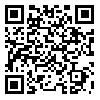BibTeX | RIS | EndNote | Medlars | ProCite | Reference Manager | RefWorks
Send citation to:
URL: http://ijpcp.iums.ac.ir/article-1-2364-en.html

 , Masoud Ahmadzad-Asl2
, Masoud Ahmadzad-Asl2 
 , Mehrasa Mohammad-Sadeghi3
, Mehrasa Mohammad-Sadeghi3 
 , Atefe Ghanbari-Jolfaei1
, Atefe Ghanbari-Jolfaei1 
 , Shabnam Nohesara4
, Shabnam Nohesara4 

2- Mental Health Research Center, Tehran Institute of Psychiatry- School of Behavioral Sciences and Mental Health, Iran University of Medical Sciences, Tehran, Iran
3- Tehran University, Tehran, Iran.
4- Mental Health Research Center, Tehran Institute of Psychiatry- School of Behavioral Sciences and Mental Health, Iran University of Medical Sciences, Tehran, Iran, IR. Fax: +9821-66506853 ,
Objectives: To assess the attachment styles in obese patients and to compare it with a group of normal weight individuals. Method: In this study, attachment styles of 159 patients with obesity who referred to centers for management of obesity were compared with 183 subjects with normal weight. The attachment styles was assessed by Hazan and Shaver’s questionnaire, body mass index (BMI) as well as self-report demographic variables. Results: Total of 342 subjects (82% female) were assessed. Average age of these individuals was 34.8 years (SD=0.6. The frequencies of secure, avoidant and preoccupied attachment styles in persons with obesity were 66%, 17% and 15% respectively. There was not any significant statistical difference between the distribution of frequency of the attachment styles in obese people and persons with normal weight (p>0.05). There were significant lower medical comorbidities in subjects with secure attachment (p<0.01). In regression analysis, the determinant factors of higher body mass index (BMI) were increased age (p<0.05), the level of education under high school diploma (p<0.05), medication consumption (p<0.05), and also being housewife (p<0.05). Conclusion: Results of this study was closely aligned with the studies that have shown the association between many of psychosomatic disorders and insecure attachment styles.
Received: 2015/10/4 | Accepted: 2015/10/4 | Published: 2015/10/4
| Rights and permissions | |
 |
This work is licensed under a Creative Commons Attribution-NonCommercial 4.0 International License. |

